tires TOYOTA AVENSIS 2013 Owners Manual (in English)
[x] Cancel search | Manufacturer: TOYOTA, Model Year: 2013, Model line: AVENSIS, Model: TOYOTA AVENSIS 2013Pages: 772, PDF Size: 34.43 MB
Page 5 of 772
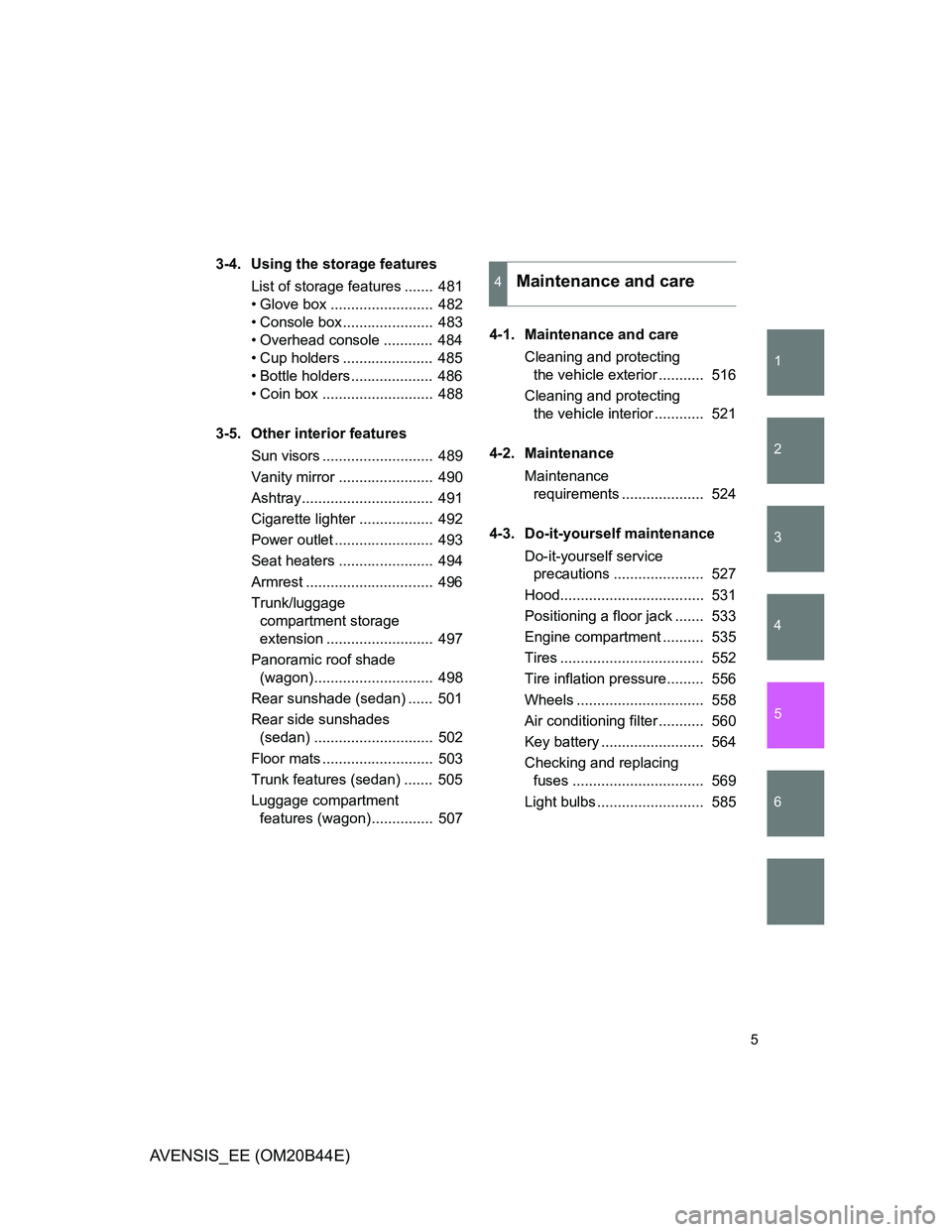
1
2
3
4
5
6
5
AVENSIS_EE (OM20B44E)
3-4. Using the storage features
List of storage features ....... 481
• Glove box ......................... 482
• Console box...................... 483
• Overhead console ............ 484
• Cup holders ...................... 485
• Bottle holders.................... 486
• Coin box ........................... 488
3-5. Other interior features
Sun visors ........................... 489
Vanity mirror ....................... 490
Ashtray................................ 491
Cigarette lighter .................. 492
Power outlet ........................ 493
Seat heaters ....................... 494
Armrest ............................... 496
Trunk/luggage
compartment storage
extension .......................... 497
Panoramic roof shade
(wagon)............................. 498
Rear sunshade (sedan) ...... 501
Rear side sunshades
(sedan) ............................. 502
Floor mats ........................... 503
Trunk features (sedan) ....... 505
Luggage compartment
features (wagon)............... 5074-1. Maintenance and care
Cleaning and protecting
the vehicle exterior ........... 516
Cleaning and protecting
the vehicle interior ............ 521
4-2. Maintenance
Maintenance
requirements .................... 524
4-3. Do-it-yourself maintenance
Do-it-yourself service
precautions ...................... 527
Hood................................... 531
Positioning a floor jack ....... 533
Engine compartment .......... 535
Tires ................................... 552
Tire inflation pressure......... 556
Wheels ............................... 558
Air conditioning filter ........... 560
Key battery ......................... 564
Checking and replacing
fuses ................................ 569
Light bulbs .......................... 585
4Maintenance and care
Page 9 of 772
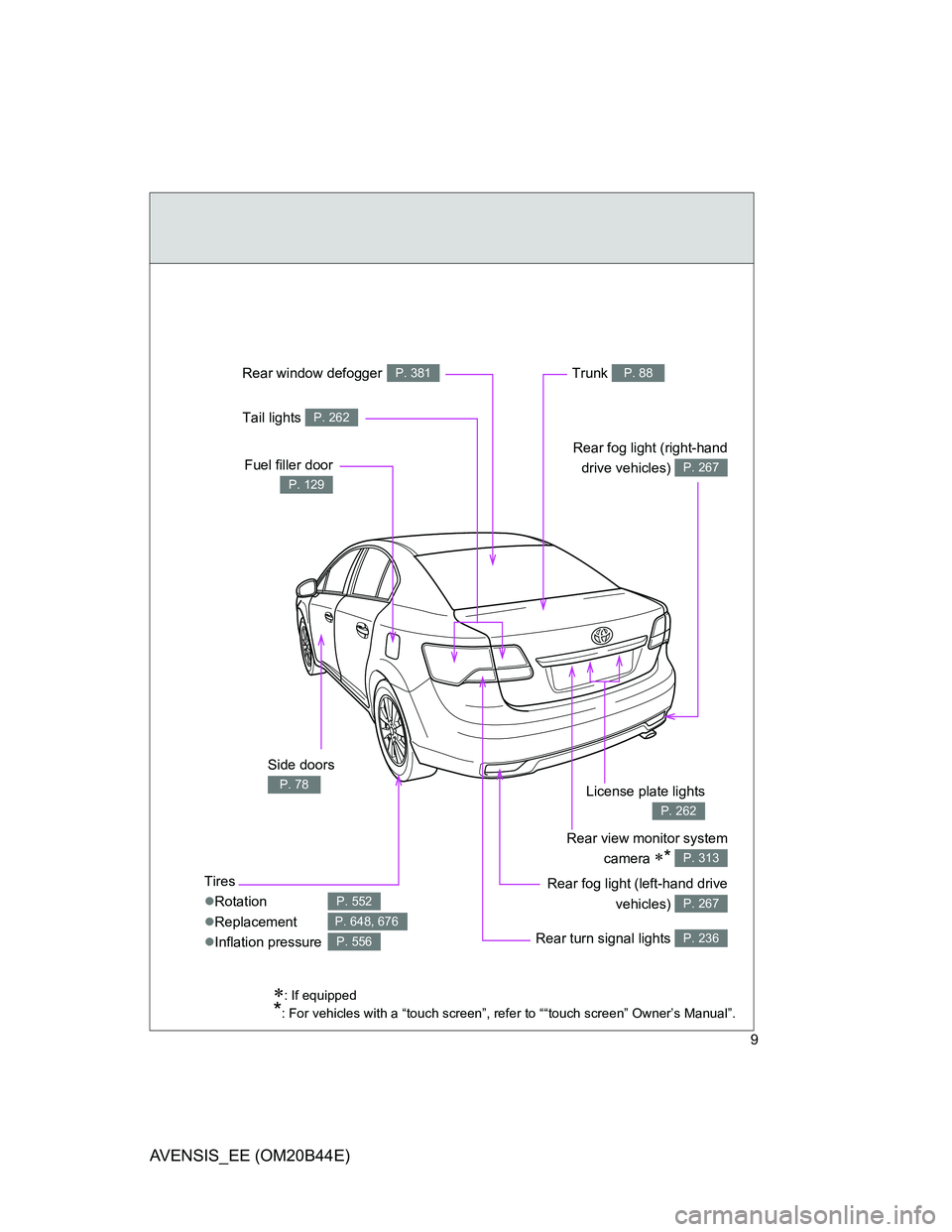
9
AVENSIS_EE (OM20B44E)
Tires
Rotation
Replacement
Inflation pressure
P. 552
P. 648, 676
P. 556
: If equipped
*: For vehicles with a “touch screen”, refer to ““touch screen” Owner’s Manual”.
Trunk P. 88
Side doors
P. 78
Fuel filler door
P. 129
Rear fog light (right-hand
drive vehicles)
P. 267
Rear window defoggerP. 381
Rear view monitor system
camera
* P. 313
Rear fog light (left-hand drive
vehicles)
P. 267
Rear turn signal lights P. 236
License plate lights
P. 262
Tail lights P. 262
Page 11 of 772
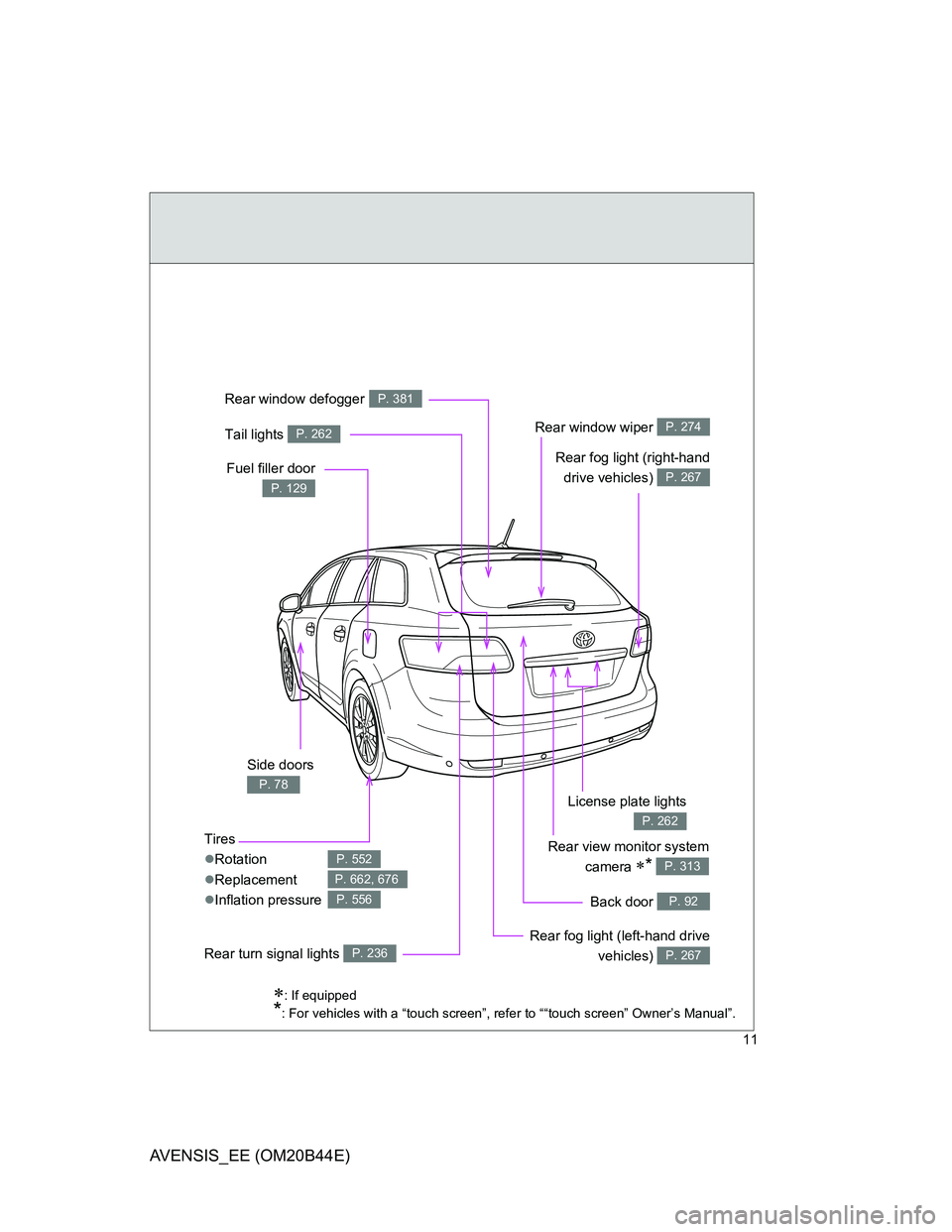
11
AVENSIS_EE (OM20B44E)
: If equipped
*: For vehicles with a “touch screen”, refer to ““touch screen” Owner’s Manual”.
Rear view monitor system
camera
* P. 313
Side doors
P. 78
Tires
Rotation
Replacement
Inflation pressure
P. 552
P. 662, 676
P. 556Back door P. 92
Fuel filler door
P. 129
Tail lights P. 262Rear window wiper P. 274
Rear window defoggerP. 381
License plate lights
P. 262
Rear fog light (left-hand drive
vehicles)
P. 267
Rear fog light (right-hand
drive vehicles)
P. 267
Rear turn signal lights P. 236
Page 197 of 772
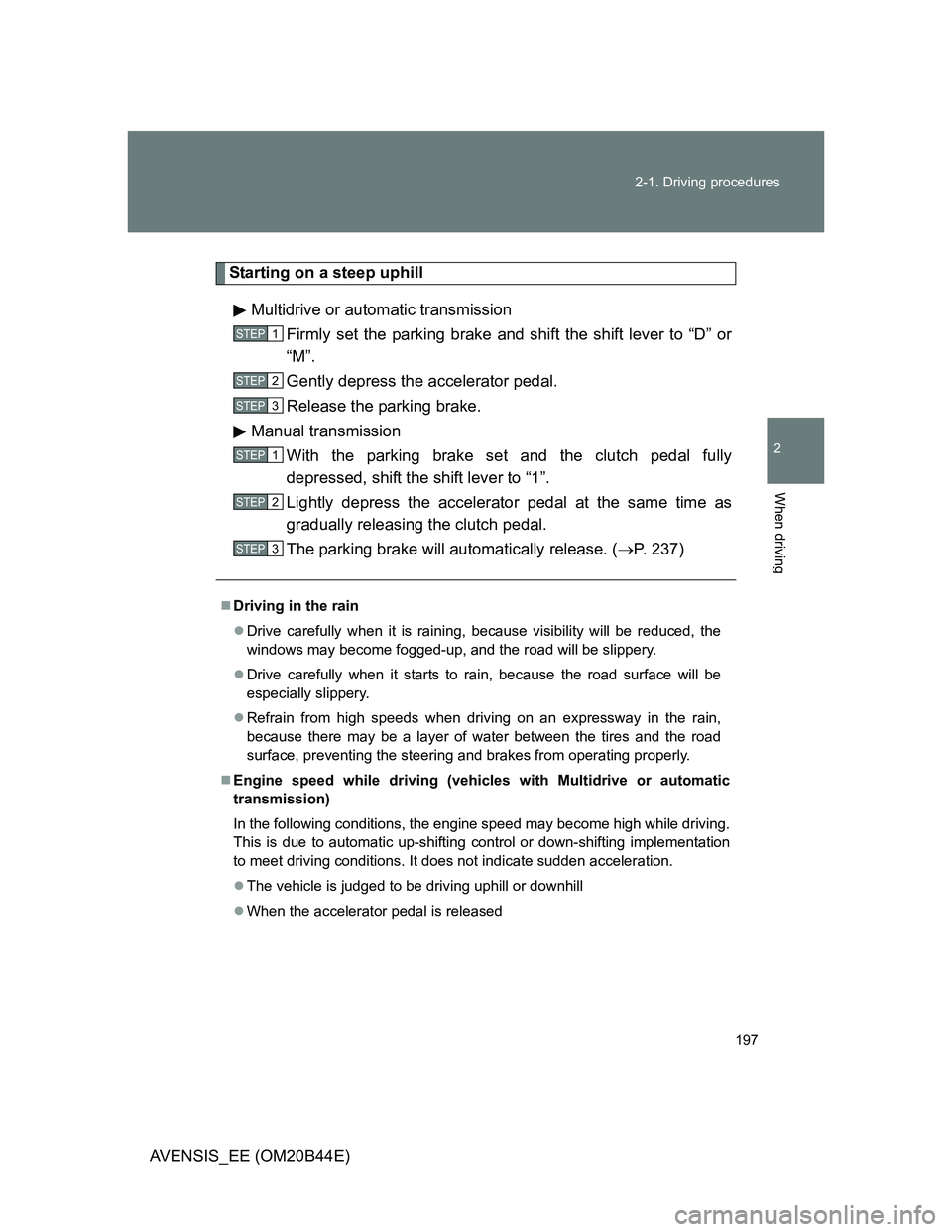
197 2-1. Driving procedures
2
When driving
AVENSIS_EE (OM20B44E)
Starting on a steep uphill
Multidrive or automatic transmission
Firmly set the parking brake and shift the shift lever to “D” or
“M”.
Gently depress the accelerator pedal.
Release the parking brake.
Manual transmission
With the parking brake set and the clutch pedal fully
depressed, shift the shift lever to “1”.
Lightly depress the accelerator pedal at the same time as
gradually releasing the clutch pedal.
The parking brake will automatically release. (P. 237)
Driving in the rain
Drive carefully when it is raining, because visibility will be reduced, the
windows may become fogged-up, and the road will be slippery.
Drive carefully when it starts to rain, because the road surface will be
especially slippery.
Refrain from high speeds when driving on an expressway in the rain,
because there may be a layer of water between the tires and the road
surface, preventing the steering and brakes from operating properly.
Engine speed while driving (vehicles with Multidrive or automatic
transmission)
In the following conditions, the engine speed may become high while driving.
This is due to automatic up-shifting control or down-shifting implementation
to meet driving conditions. It does not indicate sudden acceleration.
The vehicle is judged to be driving uphill or downhill
When the accelerator pedal is released
STEP1
STEP2
STEP3
STEP1
STEP2
STEP3
Page 317 of 772
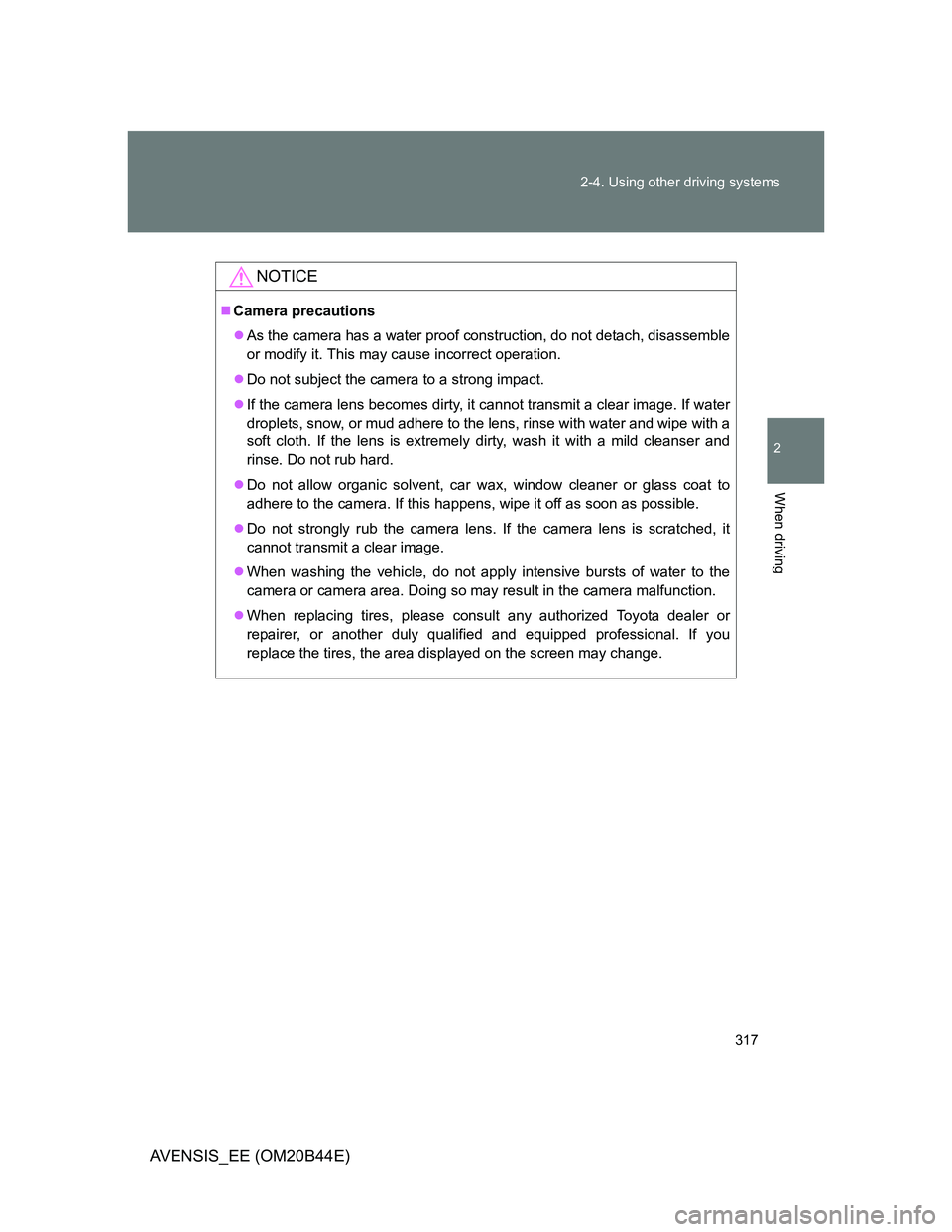
317 2-4. Using other driving systems
2
When driving
AVENSIS_EE (OM20B44E)
NOTICE
Camera precautions
As the camera has a water proof construction, do not detach, disassemble
or modify it. This may cause incorrect operation.
Do not subject the camera to a strong impact.
If the camera lens becomes dirty, it cannot transmit a clear image. If water
droplets, snow, or mud adhere to the lens, rinse with water and wipe with a
soft cloth. If the lens is extremely dirty, wash it with a mild cleanser and
rinse. Do not rub hard.
Do not allow organic solvent, car wax, window cleaner or glass coat to
adhere to the camera. If this happens, wipe it off as soon as possible.
Do not strongly rub the camera lens. If the camera lens is scratched, it
cannot transmit a clear image.
When washing the vehicle, do not apply intensive bursts of water to the
camera or camera area. Doing so may result in the camera malfunction.
When replacing tires, please consult any authorized Toyota dealer or
repairer, or another duly qualified and equipped professional. If you
replace the tires, the area displayed on the screen may change.
Page 324 of 772
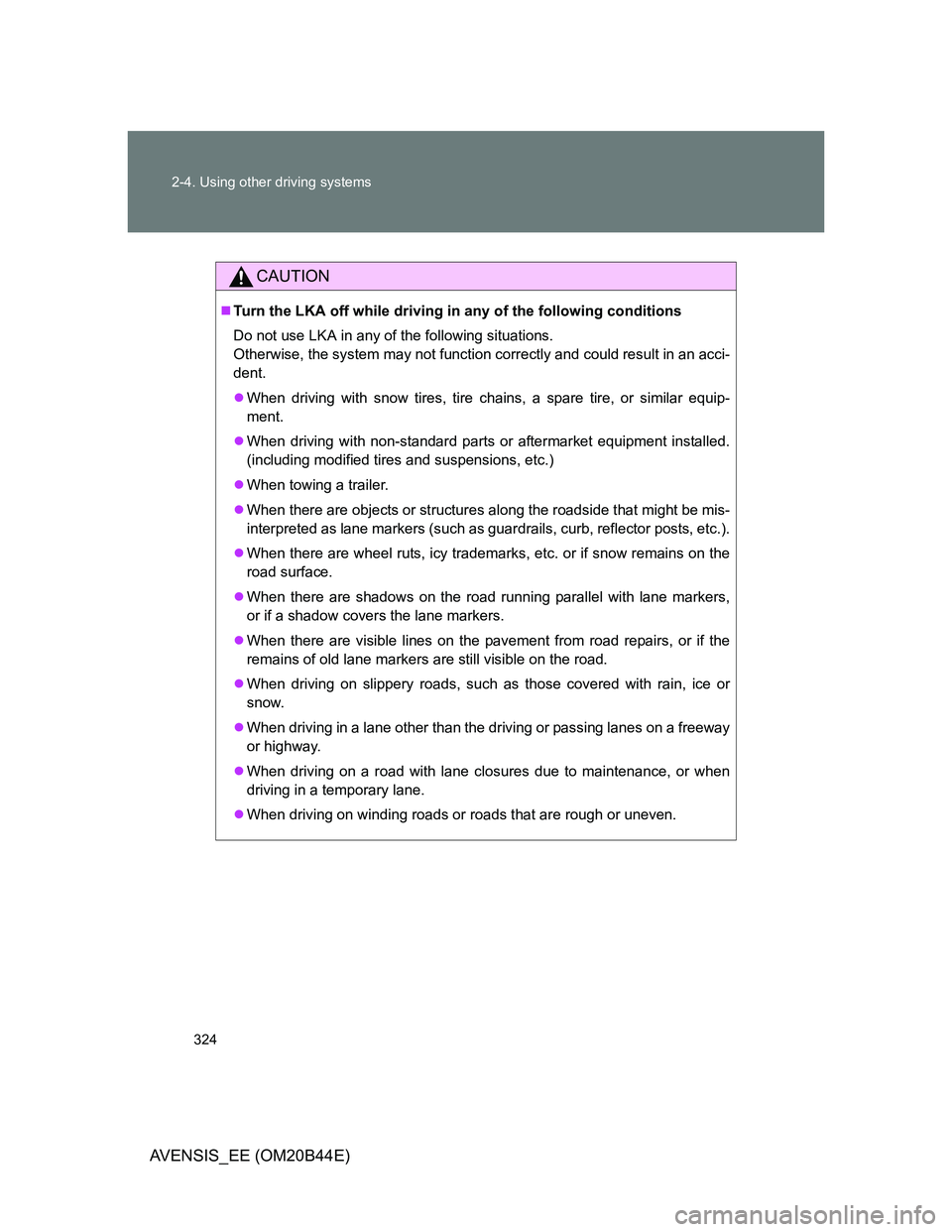
324 2-4. Using other driving systems
AVENSIS_EE (OM20B44E)
CAUTION
Turn the LKA off while driving in any of the following conditions
Do not use LKA in any of the following situations.
Otherwise, the system may not function correctly and could result in an acci-
dent.
When driving with snow tires, tire chains, a spare tire, or similar equip-
ment.
When driving with non-standard parts or aftermarket equipment installed.
(including modified tires and suspensions, etc.)
When towing a trailer.
When there are objects or structures along the roadside that might be mis-
interpreted as lane markers (such as guardrails, curb, reflector posts, etc.).
When there are wheel ruts, icy trademarks, etc. or if snow remains on the
road surface.
When there are shadows on the road running parallel with lane markers,
or if a shadow covers the lane markers.
When there are visible lines on the pavement from road repairs, or if the
remains of old lane markers are still visible on the road.
When driving on slippery roads, such as those covered with rain, ice or
snow.
When driving in a lane other than the driving or passing lanes on a freeway
or highway.
When driving on a road with lane closures due to maintenance, or when
driving in a temporary lane.
When driving on winding roads or roads that are rough or uneven.
Page 332 of 772
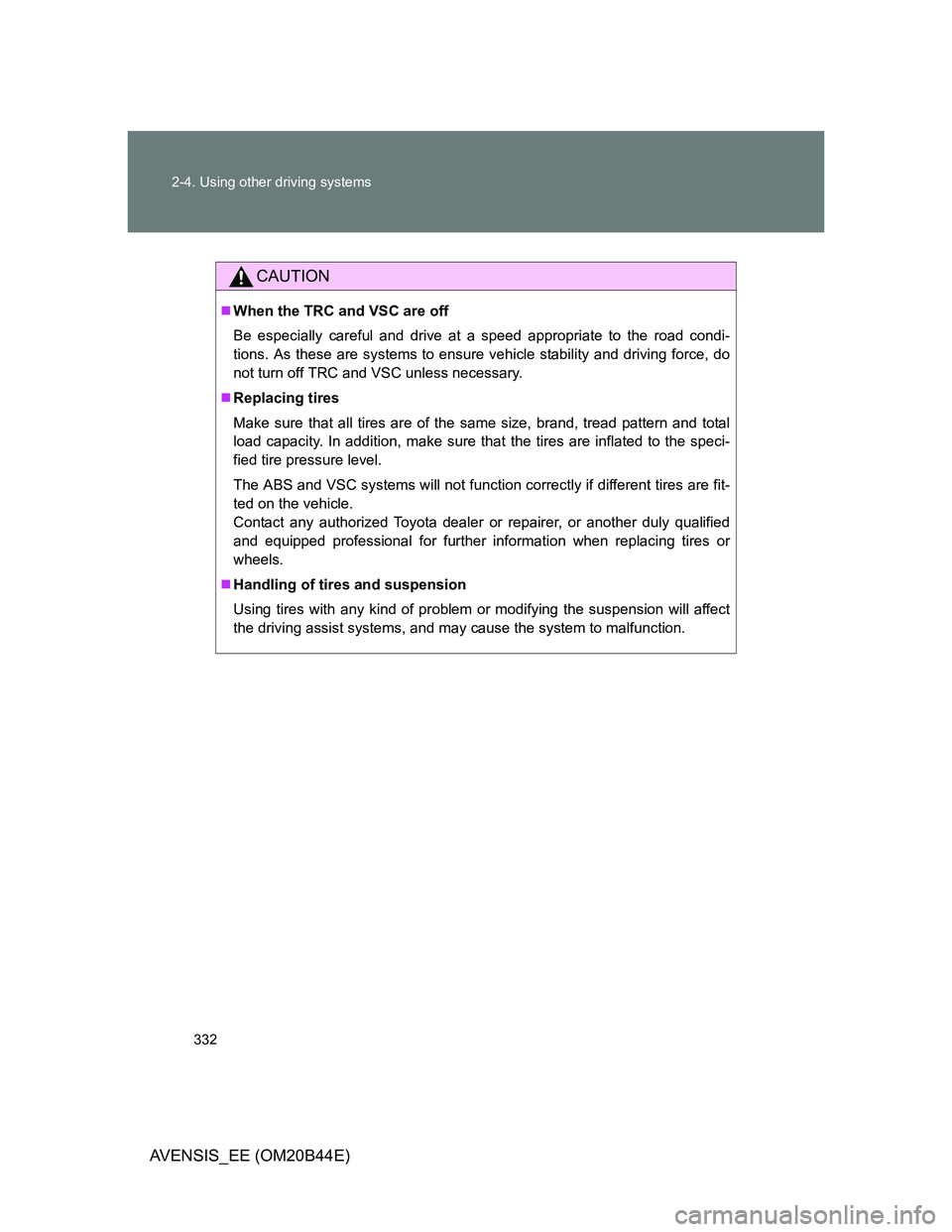
332 2-4. Using other driving systems
AVENSIS_EE (OM20B44E)
CAUTION
When the TRC and VSC are off
Be especially careful and drive at a speed appropriate to the road condi-
tions. As these are systems to ensure vehicle stability and driving force, do
not turn off TRC and VSC unless necessary.
Replacing tires
Make sure that all tires are of the same size, brand, tread pattern and total
load capacity. In addition, make sure that the tires are inflated to the speci-
fied tire pressure level.
The ABS and VSC systems will not function correctly if different tires are fit-
ted on the vehicle.
Contact any authorized Toyota dealer or repairer, or another duly qualified
and equipped professional for further information when replacing tires or
wheels.
Handling of tires and suspension
Using tires with any kind of problem or modifying the suspension will affect
the driving assist systems, and may cause the system to malfunction.
Page 344 of 772
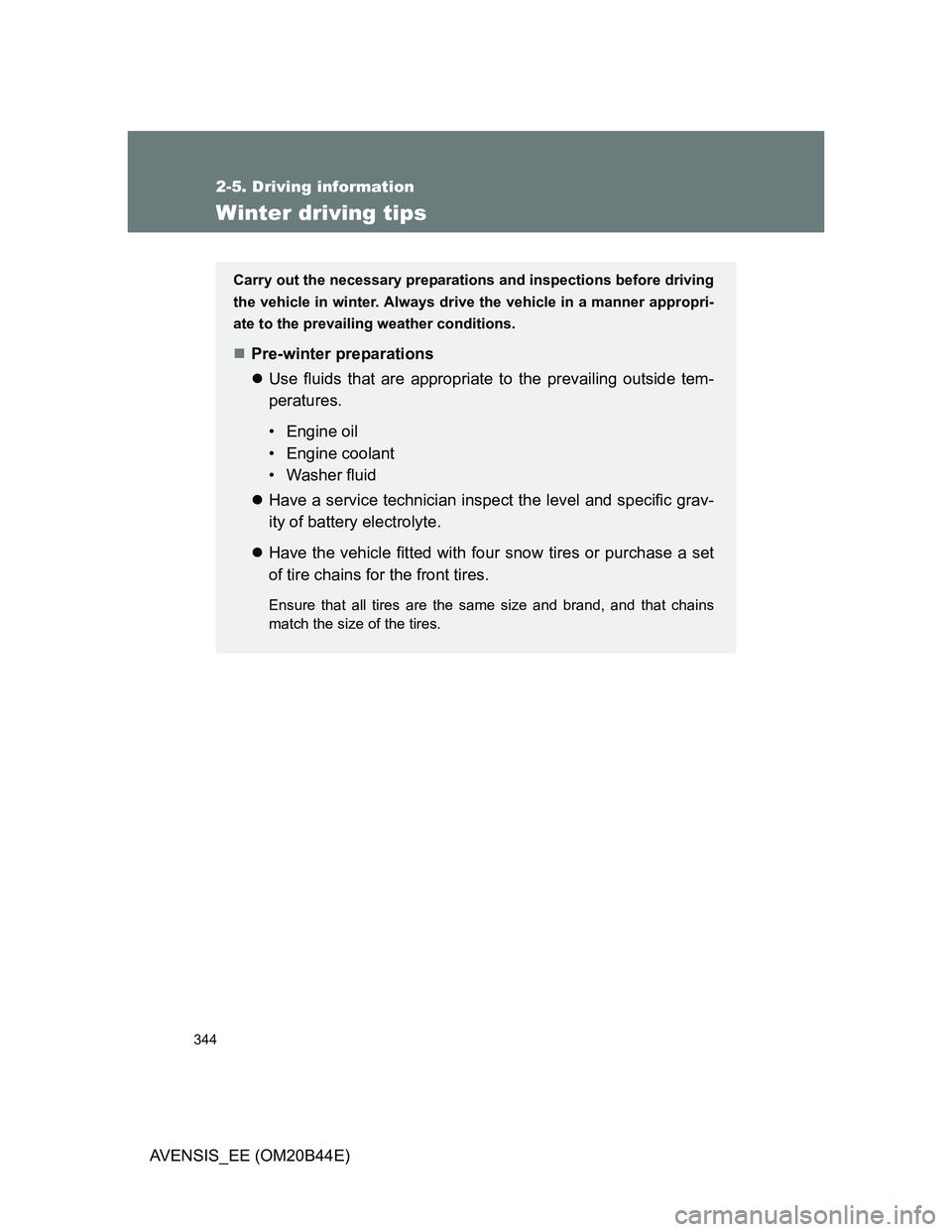
344
2-5. Driving information
AVENSIS_EE (OM20B44E)
Winter driving tips
Carry out the necessary preparations and inspections before driving
the vehicle in winter. Always drive the vehicle in a manner appropri-
ate to the prevailing weather conditions.
Pre-winter preparations
Use fluids that are appropriate to the prevailing outside tem-
peratures.
• Engine oil
• Engine coolant
• Washer fluid
Have a service technician inspect the level and specific grav-
ity of battery electrolyte.
Have the vehicle fitted with four snow tires or purchase a set
of tire chains for the front tires.
Ensure that all tires are the same size and brand, and that chains
match the size of the tires.
Page 346 of 772
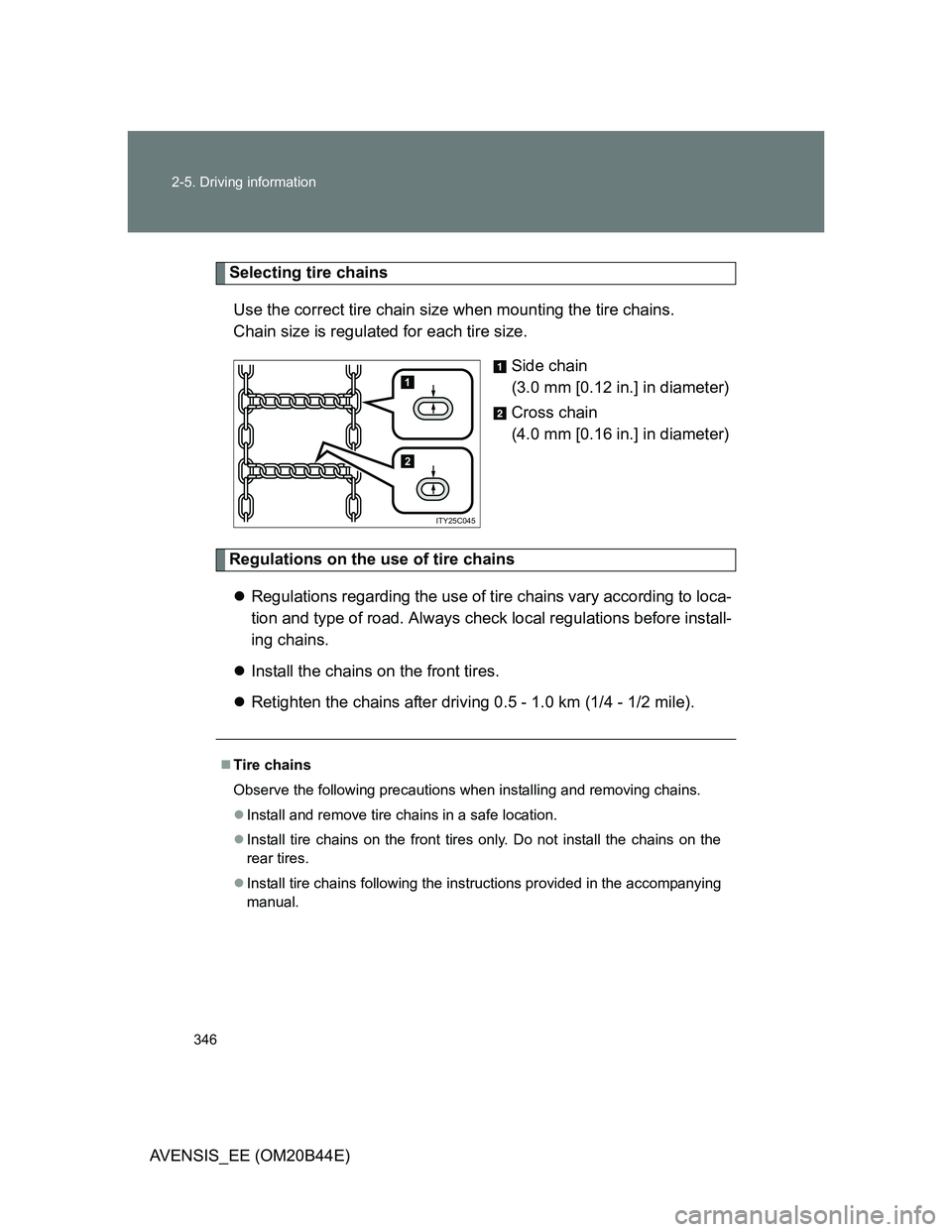
346 2-5. Driving information
AVENSIS_EE (OM20B44E)
Selecting tire chains
Use the correct tire chain size when mounting the tire chains.
Chain size is regulated for each tire size.
Side chain
(3.0 mm [0.12 in.] in diameter)
Cross chain
(4.0 mm [0.16 in.] in diameter)
Regulations on the use of tire chains
Regulations regarding the use of tire chains vary according to loca-
tion and type of road. Always check local regulations before install-
ing chains.
Install the chains on the front tires.
Retighten the chains after driving 0.5 - 1.0 km (1/4 - 1/2 mile).
1
2
ITY25C045
Tire chains
Observe the following precautions when installing and removing chains.
Install and remove tire chains in a safe location.
Install tire chains on the front tires only. Do not install the chains on the
rear tires.
Install tire chains following the instructions provided in the accompanying
manual.
Page 347 of 772
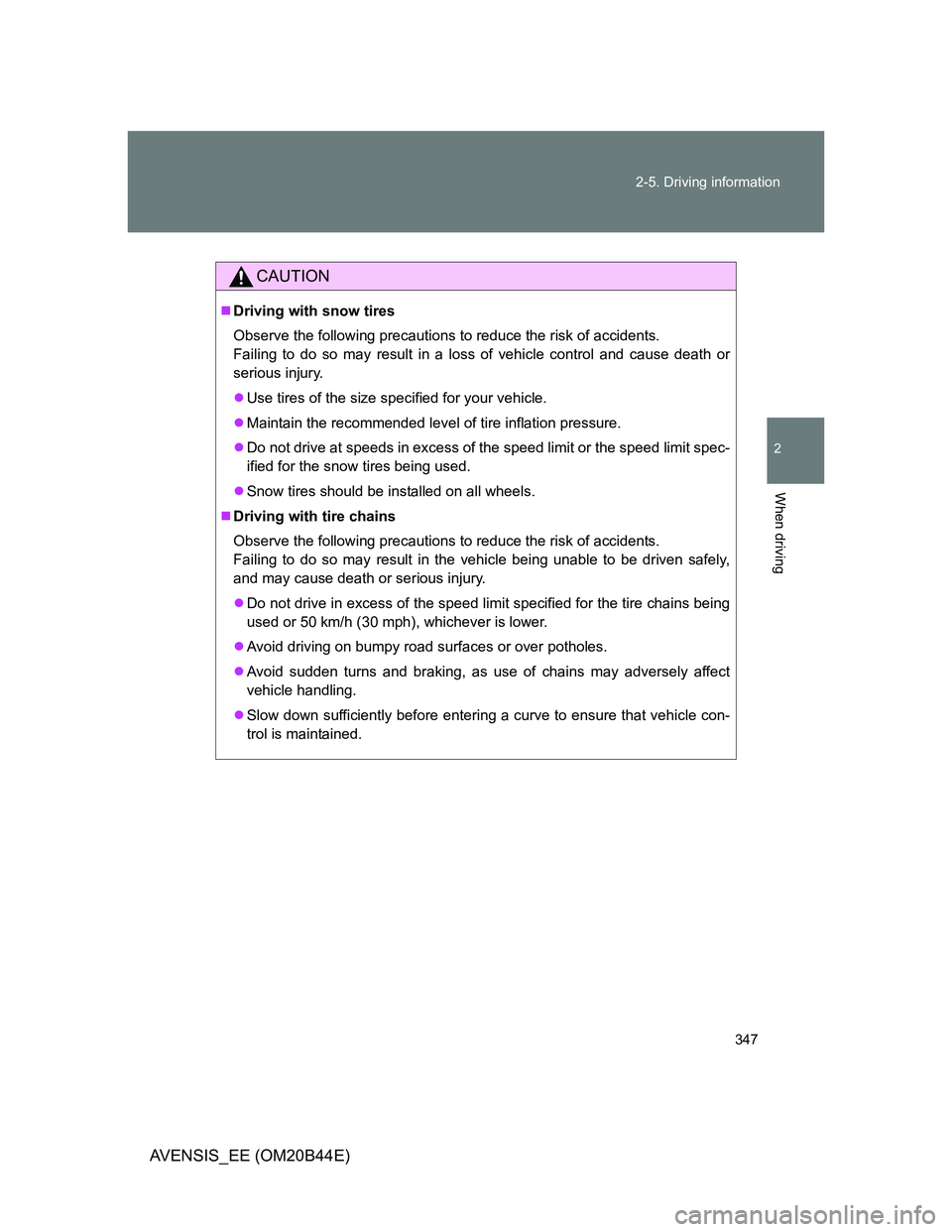
347 2-5. Driving information
2
When driving
AVENSIS_EE (OM20B44E)
CAUTION
Driving with snow tires
Observe the following precautions to reduce the risk of accidents.
Failing to do so may result in a loss of vehicle control and cause death or
serious injury.
Use tires of the size specified for your vehicle.
Maintain the recommended level of tire inflation pressure.
Do not drive at speeds in excess of the speed limit or the speed limit spec-
ified for the snow tires being used.
Snow tires should be installed on all wheels.
Driving with tire chains
Observe the following precautions to reduce the risk of accidents.
Failing to do so may result in the vehicle being unable to be driven safely,
and may cause death or serious injury.
Do not drive in excess of the speed limit specified for the tire chains being
used or 50 km/h (30 mph), whichever is lower.
Avoid driving on bumpy road surfaces or over potholes.
Avoid sudden turns and braking, as use of chains may adversely affect
vehicle handling.
Slow down sufficiently before entering a curve to ensure that vehicle con-
trol is maintained.